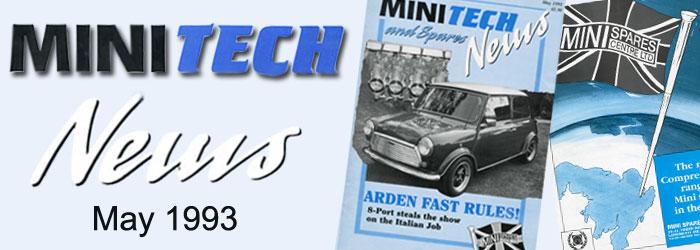LIGHTENING STRIKES TWICE IN THE SAME PLACE
As a follow-up to the introduction of our alloy roller-tip rocker, further attention was lavished upon the valve train.
Although there has been a carbon-fibre push rod available for some time, it is in 5/16" diameter. This somewhat over-engineered size meant that awkward and time consuming alterations to cylinder block and head had to be carried out so that they can .be a) fitted and b) work without breakage caused by rubbing. Basically a good idea, but little consideration to fitment, and seemingly little R & D.
The number of enquiries we have had about the use and fitment of carbon-fibre push rods ha~ been steadily increasing, however, sales wereWlimited because of fitting hassles. This prompted us into looking into just why 5/16" diameter rod was necessary, bearing in mind, the standard steel item is only 1/4".
Carbon-fibre is much stronger, weight for weight than steel, so 5/16" diameter must have been chosen as the nearest size down that would actually fit, albeit needing modifications to its intended environmemt.
Some discussions were entered into with a guy who specialises in carbon-fibre products, mainly for Formula 1 teams. It was quickly established that wherever carbon fibre, or indeed any material is issued to replace the standard item, each component should be viewed and tested in conditions in which it is expected to operate. Some tests and experiments in the past have been carried out that prove unnecessary and irrelevant points for such items. In applying this, a push rod is required to do just that push. This means that the push rods performance needed to be tested in compressibn to test its deflection in that condition. After some further thought, a special test rig was made to assess and measure components used in this fashion. As the push rod was not required to support weight as a beam, there was no point in hanging weight from its centre to asess its deflection under that condition. Flexure in push rods is mainly caused by the motion of passing through its operating arc. Basically, when the valve is closed the rocker assumes a certain attitude. When the valve is opened to full lift by the push rod via the rocker, the push rod passes through a few degrees of an arc. The higher the rpm range used, the faster the push rod moves through this arc. This rising speed, combined with the weight of the push rod, increases the mass of the push rod passing through the arc. However, this flexure is VERY small, and only has effectt at high rpm - such as race engines - using 8000rpm plus.
The standard steel push rod was tested first, then the walready available 5/16" carbon fibre push rod. The results were much as expected, the carbon fibre push i r<;ldbe.ing very much ~tro~~tthan the st~el one - over 2 1/2 times stronger In fact. The question was then asked why does it need to be that much stonger - since the steel push rod rarely shows short-comings. Only in full race engines using very high rpm and very strong valve springs with high ratio rockers have they displ.C!:¥ed those short-comings. Especiall¥ in view of th.e necessary modifications nee<;ted to fit the 5/16" push rods.
More head scratching and professional "quesstimation" saw what was considered the obivous starting point - a carbon fibre push rod at the same diameter as the steel one - 1/4". One was produced and performance tested on our test rig. The man that knows about carbon fibre said this would more than likely be sufficient, and he was not wrong. Despite being half the weight of the standard push rod, it's compression strength was one and a half times greater. Exactly what we were after - especially in view of the fact that it is a DIRECT replacement for the standard one with no machining required. In operation, its flexure is minimised by the vast reduction in weight (therefore greatly reducing its mobile mass) to a point hardly worth a mention. The question we then asked ourselves was what justified the extra expense of a set of carbon fibre push rods over conventional steel ones.
Well, .. apart from the decrease in weight by 50% (therefore helping the valve springs cope better at higher rpm), and its greater compressional strength (more control over valve operation at high rpm) what was there?
Massively reduced expansion when hot AND almost total absence of resonance. The two latter benefits apply acutely to modern emission standard forJl1odified road vehicles. Tighter valve clearances can be maintained to help reduce emissions. Carbon-fibre does not resonate, so valve train noise is reduced. In fact when in conjunction with our bushed, alloy, roller tip rockers and an alloy rocker cover - valve train . noise is Significantly reduced. Definitely an all important part of performance road engines for the future.
Importation rules regarding vehicles are very specific: Only those over 25 years in age may be brought in to the USA without compilance to Federal Motor Vehicle Safety Standards (FMVSS).Author
admin

